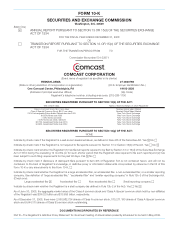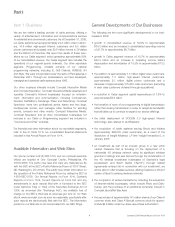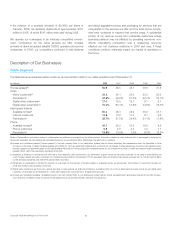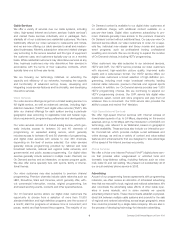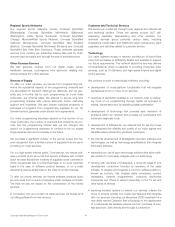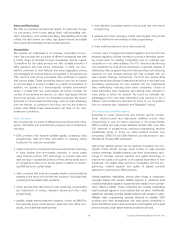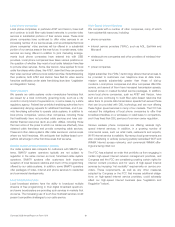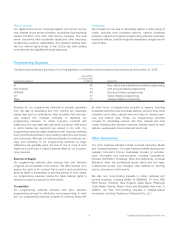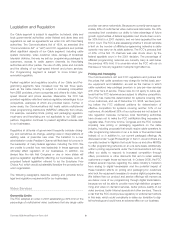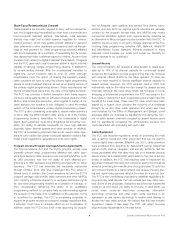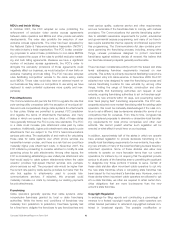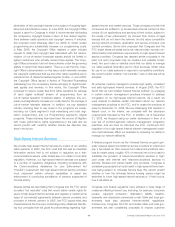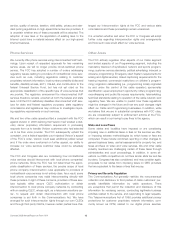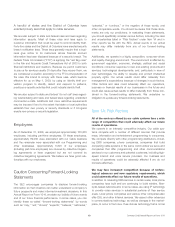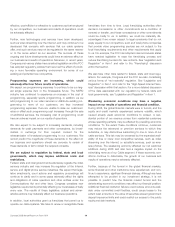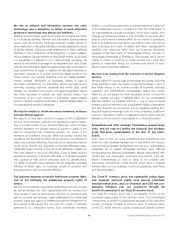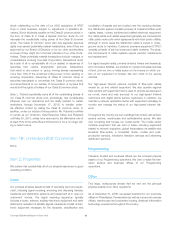Comcast 2008 Annual Report Download - page 8
Download and view the complete annual report
Please find page 8 of the 2008 Comcast annual report below. You can navigate through the pages in the report by either clicking on the pages listed below, or by using the keyword search tool below to find specific information within the annual report.Local phone companies
Local phone companies, in particular AT&T and Verizon, have built
and continue to build fiber-optic-based networks to provide video
services in substantial portions of their service areas. These local
phone companies have continued to offer video services in an
increasing number of our service areas, and we anticipate that local
phone companies’ video services will be offered in a substantial
portion of our service areas in the near future. In certain areas, video
services are being offered in addition to joint marketing arrange-
ments local phone companies have entered into with DBS
providers. Local phone companies have taken various positions on
the question of whether they need a local cable television franchise
to provide video services. Some, like Verizon, have applied for local
cable franchises while others, like AT&T, claim that they can provide
their video services without a local cable franchise. Notwithstanding
their positions, both AT&T and Verizon have filed for video service
franchise certificates under state franchising laws (see “Legislation
and Regulation” below).
Other providers
We operate our cable systems under nonexclusive franchises that
are issued by a local community governing body, such as a city
council or county board of supervisors or, in some cases, by a state
regulatory agency. Federal law prohibits franchising authorities from
unreasonably denying requests for additional franchises, and it per-
mits franchising authorities to operate cable systems. In addition to
local phone companies, various other companies, including those
that traditionally have not provided cable services and have sub-
stantial financial resources (such as public utilities, including those
that own some of the poles to which our cables are attached), have
obtained cable franchises and provide competing cable services.
These and other cable systems offer cable services in various areas
where we hold franchises. We anticipate that facilities-based com-
petitors will emerge in other franchise areas that we serve.
Satellite master antenna television systems
Our cable systems also compete for customers with SMATV sys-
tems. SMATV system operators typically are not subject to
regulation in the same manner as local, franchised cable system
operators. SMATV systems offer customers both improved
reception of local television stations and much of the programming
offered by our cable systems. In addition, some SMATV operators
offer packages of video, Internet and phone services to residential
and commercial developments.
Local broadcast services
Local broadcast stations have the ability to broadcast multiple
streams of free programming in their digital broadcast spectrum,
and some broadcasters are providing such services in markets that
we serve. The increasing use of such free multicast services could
present competitive challenges to our cable service.
High-Speed Internet Services
We compete with a number of other companies, many of which
have substantial resources, including:
• phone companies
• Internet service providers (“ISPs”), such as AOL, Earthlink and
Microsoft
• wireless phone companies and other providers of wireless Inter-
net service
• power companies
Digital subscriber line (“DSL”) technology allows Internet access to
be provided to customers over telephone lines at data trans-
mission speeds substantially greater than those of dial-up
modems. Local phone companies and other companies offer DSL
service, and several of them have increased transmission speeds,
lowered prices or created bundled service packages. In addition,
some local phone companies, such as AT&T and Verizon, have
built and are continuing to build fiber-optic-based networks that
allow them to provide data transmission speeds that exceed those
that can be provided with DSL technology and are now offering
these higher speed services in many of our markets. The FCC has
reduced the obligations of local phone companies to offer their
broadband facilities on a wholesale or retail basis to competitors,
and it has freed their DSL services of common carrier regulation.
Various wireless phone companies are offering wireless high-
speed Internet services. In addition, in a growing number of
commercial areas, such as retail malls, restaurants and airports,
Wi-Fi Internet service is available. Numerous local governments are
also considering or actively pursuing publicly subsidized Wi-Fi and
WiMAX Internet access networks, and commercial WiMAX offer-
ings are being rolled out.
The FCC has adopted an order that prohibits us from engaging in
certain high-speed Internet network management practices, and
Congress and the FCC are considering creating certain rights for
Internet content providers and for users of high-speed Internet
services by imposing “net neutrality” requirements on service pro-
viders. These requirements, as well as any other measures
adopted by Congress or the FCC that impose additional obliga-
tions on high-speed Internet service providers, could adversely
affect our high-speed Internet business (see “Legislation and
Regulation” below).
Comcast 2008 Annual Report on Form 10-K 6

